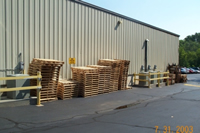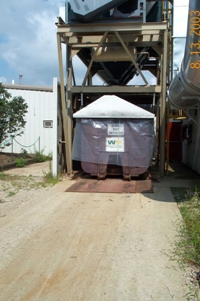Industrial storm water permit no-exposure facilities
No exposure means all industrial materials and activities at a facility are protected by a storm-resistant shelter to prevent exposure to rain, snow, snowmelt and/or runoff.
To request the conditional no exposure exclusion, an appropriate representative of the facility must submit No Exposure Certification application through the DNR's online ePermitting system found on the industrial storm water permit forms page.
Industrial materials and activities include, but are not limited to:
- material handling equipment or activities;
- industrial machinery;
- raw materials;
- intermediate products;
- by-products and final products; and
- waste products.
Material handling activities include storage, loading and unloading, transportation or conveyance of any raw material, intermediate product, by-product, final product or waste product. Many final products that are meant to be used outdoors - automobiles, for example, pose little risk of storm water contamination, because pollutants for those products cannot be mobilized by precipitation or runoff. Therefore, some final products are exempt from the requirement that they are sheltered to qualify for no exposure.
Clean wooden pallets do not expose storm water to pollutants.
Similarly, the containers, racks, and other transport platforms wooden pallets, for example, used for the storage or conveyance of these final products can also be stored outside, providing the containers, racks and platforms are pollutant-free.
Storm-resistant shelters include completely roofed and walled buildings or structures, as well as structures with only a top cover but no side coverings, provided material under the structure is not otherwise subject to any run-on and subsequent runoff of storm water.
There are circumstances where permanent, uninterrupted sheltering of industrial activities or materials is not possible. Under such conditions:
- materials and activities may be sheltered with such temporary covers as tarpaulins until permanent enclosure can be achieved or
- temporary sheltering of industrial materials and activities may only be allowed during facility renovation or construction.
Industrial materials and activities that do not require a storm-resistant shelter
While the intent of the no exposure exclusion is to promote a condition of permanent no exposure, a storm-resistant shelter is not required for the following industrial materials and activities.
- Drums, barrels, tanks and similar containers that are sealed (e.g banded or otherwise secured and without operational taps or valves are not exposed provided those containers are not deteriorated and do not leak). Unless these containers are opened while outdoors or are deteriorated or leak, they will likely not constitute a risk of contaminating storm water runoff. Consider the following in making your no-exposure determination:
- Containers can only be stored outdoors; any addition or withdrawal of material to or from containers while outdoors will not allow certification for no exposure.
- Simply moving containers while outside does not create exposure.
- Inspect all outdoor containers to ensure they are not open, deteriorated or leaking.
- Any time external containers are open, deteriorated or leaking, they must immediately be closed, replaced or sheltered.
- Racks and other transport platforms used with the drums or other containers can be stored outside providing they are contaminant-free.
- Above Ground Storage Tanks (ASTs).
In addition to generally being considered not exposed, ASTs may also be exempt from the prohibition against adding or withdrawing material to / from external containers. ASTs typically utilize transfer valves to dispense materials which support facility operations (e.g., heating oil, propane, butane, chemical feedstocks) or fuel for delivery vehicles (gasoline, diesel, compressed natural gas). For ASTs to be operational and qualify for no exposure:- they must be physically separated from and not associated with vehicle maintenance operations;
- there must be no piping, pumps or other equipment leaking contaminants that could contact storm water;
- wherever feasible, ASTs must be surrounded by some type of physical containment (for example, an impervious dike, berm or concrete retaining structure) to prevent runoff in the event of a structural failure or leaking transfer valve.
- A covered roll-off prevents storm water contact.
Lidded dumpsters containing waste materials are also considered excluded, providing the containers are completely covered and nothing can drain out holes in the bottom, or is lost during loading onto a garbage truck. Industrial refuse and trash or other material that is stored uncovered in dumpsters, luggers or roll offs, however, is considered exposed. Adequately maintained vehicles, such as trucks, automobiles, forklifts, trailers or other general-purpose vehicles found onsite but not industrial machinery are considered excluded, so long as the vehicles are not leaking or are otherwise a potential source of contaminants.
Vehicles passing between buildings will likely come into contact with precipitation at some time, but as long as they are adequately maintained they will not cause a condition of exposure. Similarly, non-leaking vehicles awaiting maintenance at vehicle maintenance facilities are not considered exposed. The mere conveyance between buildings of materials or products that would otherwise not be allowed to be stored outdoors does not create a condition of exposure, again provided the materials or products are adequately protected from precipitation and could not be released as a result of a leak or spill.
- Final products built and intended for use outdoors (e.g new cars are excluded, provided the final products have not deteriorated or are otherwise a potential source of contaminants).
Types of final products not qualifying for a No Exposure Certificate
- Products that would be mobilized in storm water discharges (e.g rock salt).
- Products that may, when exposed, oxidize, deteriorate, leak or otherwise be a potential source of contaminants (e.g junk cars; stockpiled train rails, junked equipment).
- Final products which are, in actuality, "intermediate" products. Intermediate products are those used in the composition of yet another product (e.g sheet metal, tubing and paint used in making tractors are good examples of intermediate products).
- Even if the intermediate product is final for a manufacturer and destined for incorporation in a final product intended for use outdoors, these products are not allowed to be exposed because they may be chemically treated or are not impervious to weathering.
Other potential sources of contaminants
- Particulate emissions from roof stacks and/or vents.
Particulate emissions from roof stacks or vents do not cause a condition of exposure, provided they are in compliance with other applicable environmental protection programs The DNR, air programs for example and do not cause storm water contamination. Deposits of particles or residuals from roof stacks or vents not otherwise regulated and which could be mobilized by storm water runoff, are considered exposed. Exposure also occurs when, as a result of particulate emissions, pollutants can be seen being "tracked out" or carried on the tires of vehicles. - Acid rain leachate.
Industrial facilities are also responsible for storm water discharges that contain pollutants resulting from the leaching effect of acidic rain or snow on metal building structures. Therefore, when asking for a no exposure certification, operators must be aware of the existence of structural elements that could be soluble as a result of contact with acid rain and uncoated copper roofs for example. If the dissolved metals or other contaminants could cause or contribute to a water quality violation, the DNR cannot grant a certificate of no exposure. - Pollutants potentially mobilized by wind.
Windblown raw materials cause a condition of exposure. This is to alert operators to situations where materials sheltered from precipitation can still be deemed exposed if the materials can be mobilized by wind.


